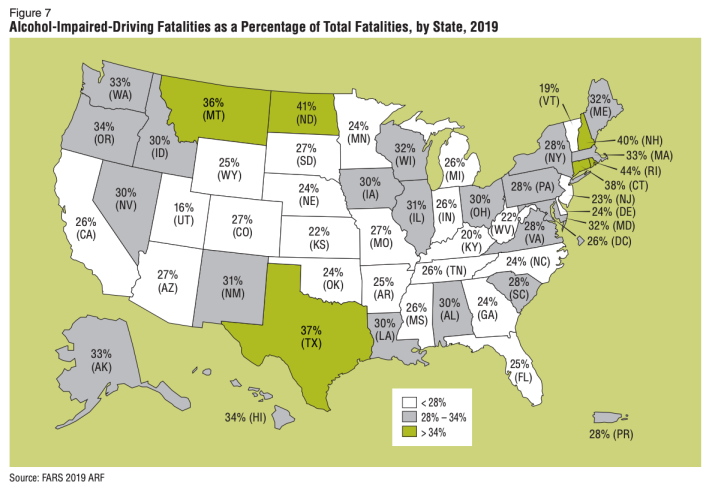Car crash rates increased after the legalization of marijuana in Western states, a pair of new studies finds — but increasing access to transit may be the only sure-fire way to rein in stoned driving, especially without increasing police harassment of people of color.
In a set of linked studies from the Insurance Institute for Highway Safety and Highway Loss Data Institute, researchers found that new marijuana legalization policies in California, Colorado, Nevada, Oregon, and Washington were correlated with a 6-percent increase in injury-causing car crash rates in the months that followed.
That might not seem like huge jump — again, we're talking car crash rate, not sheer crashes — but the team behind the study says America simply can’t afford to add to its impaired driving death totals, especially as policymakers continue to fail to curb the drunk driving epidemic.
“America has been stuck at about 10,000 [alcohol-related] deaths per year for a decade, and we haven’t been able to fix it,” said David Harkey, president of the Institute. “The last thing we want to do is have new substances introduced to the population in a way that that makes those numbers any worse.”
But Harkey was careful to note that addressing stoned driving won’t be as simple as restricting access to cannabis — because stoned driving, on its own, may not even be the real problem.

In the second study in the series, IIHS looked at emergency room data in three states that had recently legalized weed, and found that drivers who used marijuana alone “were no more likely to be involved in crashes than drivers who hadn’t used the drug” — but drivers who had marijuana and alcohol in their systems were five times more likely to have been put in the hospital by a collision. (Drivers who had only consumed alcohol were only three times more likely.)
Stoned drivers, stalled technology
The findings underscore the thorny challenges of keeping impaired drivers off the road in a country that consistently fails to give people alternative ways to get around when they’ve indulged in mind-altering substances.
Though marijuana consumption alone might not necessarily make a driver more likely to be involved in a crash, many researchers still agree that any cannabis consumption is probably a bad idea for motorists, because marijuana users who also drink are highly likely to consume both substances at the same time. In addition, cannabis has been shown to inhibit driver reaction times and make stoned motorists more likely to weave between lanes than sober ones — though interestingly, stoned drivers also tend to slow way down and stop tailgating other motorists.
To compound the problem even further, law enforcement officers have yet to find efficient ways to tell whether or not a driver is stoned at all, much less set meaningful legal standards for how much weed is too much weed to safely get behind the wheel for drivers with varying tolerance levels.
Blood, saliva and urine tests can take multiple days to process, and they don’t tell doctors whether the driver blazed up a week ago or just moments before buckling in. Emerging breathalyzer technology that detects THC on a driver’s breath can reliably tell whether she’s smoked marijuana in the last three hours or so, but not whether she’s consumed an edible cannabis product — and the devices can’t yet tell how much marijuana she’s eaten or inhaled. Researchers are studying whether cognitive assessments in the field might be a better way to tell if someone is too high to drive — think a next-gen version of the “walk and turn” test for alcohol-impaired motorists —but for now, there’s no gold standard for evaluating unsafe levels of marijuana intoxication for road users, either in the right of way or in the lab.
Even if such a gold standard did exist, there’s no guarantee that it would be applied equitably to everyone — especially given how racist and violent the enforcement of marijuana-related offenses has always been in the U.S. In the wake of the George Floyd protests, states across the country are repealing pretextual stop laws that allow law enforcement officers to approach suspects simply because they claim they smell the odor of marijuana; in the context of a structurally racist police force, such dangerously subjective policies notoriously lead to over-enforcement of BIPOC communities that can all too easily escalate to the murder of the "suspect" by the officer. Whether or not researchers ever discover more scientific ways of determining THC intoxication levels in the field, few advocates are keen to give police even more authority and tools to harass people of color, even if they recognize that stoned drivers pose a danger to other road users.
Transit as a DUI-Reduction Strategy
Still, Harkey says that America has to do something about the rise of smoke on our roads, especially as more and more states continue to legalize it: a whopping 45 states have at least decriminalized marijuana for medical use, and it’s fully legal for recreational use in 18 of them.
“It’s early, but all the results are trending in the wrong direction,” said Harkey. “Across all the studies we’re doing, the results consistently seem to indicate that marijuana is having an increased risk on road safety. Policymakers need to understand that that risk is there, and they need to figure out how to support dealing with that increased risk, whether it’s supporting research to better understand THC impairment, or providing support to law enforcement to get more impaired drivers off the road, —no matter what they consumed.”
But Harkey also says for those who are hesitant to lean on enforcement-based solutions — or those who want police out of traffic enforcement altogether — there’s another way to reduce drug- and alcohol-impaired driving: decreasing driving, period, by investing robustly in transit.
“Zero tolerance does not mean you can’t go out and have a good time and consume various products that might impair you — or consume marijuana for medical purposes,” said Harkey. “You just have to have a way to get home that doesn’t involve getting behind the wheel.”






